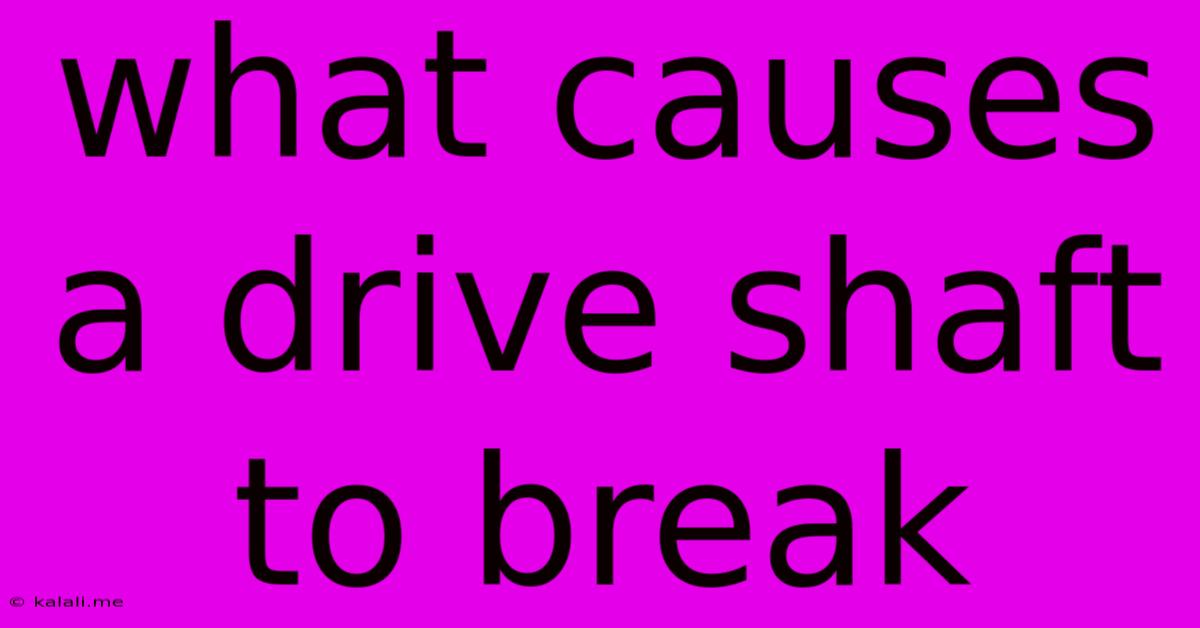What Causes A Drive Shaft To Break
Kalali
Jun 10, 2025 · 3 min read

Table of Contents
What Causes a Driveshaft to Break? A Comprehensive Guide
A broken driveshaft is a serious issue, leaving your vehicle stranded and potentially causing significant damage. Understanding the underlying causes can help you prevent this costly and inconvenient breakdown. This comprehensive guide explores the various factors contributing to driveshaft failure, from simple wear and tear to more complex mechanical problems. This article will help you understand common causes, preventative measures, and the telltale signs of a failing driveshaft.
Understanding the Driveshaft's Role
Before diving into the causes of failure, let's briefly understand the driveshaft's function. The driveshaft, also known as a propeller shaft, transmits power from the transmission to the differential, enabling the wheels to rotate. This crucial component is subjected to significant stress and strain during operation, making it susceptible to various forms of damage.
Common Causes of Driveshaft Failure:
Several factors can contribute to a driveshaft breaking, ranging from normal wear and tear to serious mechanical issues. Here's a breakdown of the most frequent culprits:
1. Wear and Tear:
-
U-Joint Wear: Universal joints (U-joints) are critical components within the driveshaft, allowing for angular movement. Over time, these joints wear down, resulting in excessive play and vibration. This excessive movement puts significant stress on the driveshaft, eventually leading to cracks and eventual failure. Regular inspection and lubrication are key to extending their lifespan.
-
Excessive Vibration: Constant exposure to vibration, particularly on rough roads or with unbalanced tires, weakens the driveshaft material over time, making it prone to fatigue fractures. This is exacerbated by worn suspension components that amplify vibrations.
-
Corrosion: Exposure to road salt and moisture can cause corrosion, especially in areas with harsh winters. This corrosion weakens the driveshaft's structure, increasing the risk of failure. Regular cleaning and anti-rust treatments can help mitigate this issue.
2. Misalignment Issues:
-
Improper Installation: Incorrect installation of the driveshaft during repair or replacement can lead to misalignment, resulting in excessive stress and premature wear. Professional installation is highly recommended.
-
Damaged Transmission or Differential Mounts: Worn or damaged mounts allow excessive movement of the transmission and differential, putting the driveshaft out of alignment. This misalignment introduces uneven stress, ultimately leading to breakage.
-
Bent or Damaged Driveshaft: A driveshaft that has been impacted, for example by hitting a curb or object, can become bent or damaged, causing misalignment and increasing the chances of failure.
3. Other Contributing Factors:
-
Lack of Maintenance: Neglecting routine maintenance, including lubrication and inspections, accelerates wear and tear and significantly increases the risk of failure.
-
Overloading: Exceeding the vehicle's weight capacity puts excessive stress on the driveshaft, increasing the likelihood of breakage.
-
Sudden Impacts: Large impacts, such as hitting a pothole at high speed or driving over a significant obstacle, can cause sudden, severe stress on the driveshaft resulting in immediate fracture.
Recognizing the Signs of a Failing Driveshaft:
Early detection is crucial. Here are some warning signs to watch out for:
-
Excessive Vibration: A noticeable increase in vibration, especially at higher speeds, is a common indicator of a problem.
-
Clunking or Popping Noises: Unusual noises emanating from the drivetrain often suggest a problem with the U-joints or driveshaft.
-
Visible Damage: Look for signs of damage such as cracks, bends, or leaks from U-joint seals.
Preventing Driveshaft Failure:
- Regular Inspections: Schedule regular inspections as part of routine vehicle maintenance.
- Proper Lubrication: Keep U-joints properly lubricated according to manufacturer recommendations.
- Address Vibration Issues: Fix any issues that cause excessive vibration, such as worn suspension components or unbalanced tires.
- Professional Installation: Ensure proper installation during any driveshaft repairs or replacements.
Ignoring a failing driveshaft can lead to catastrophic consequences. Regular maintenance and prompt attention to warning signs are essential to ensure your vehicle's safety and longevity.
Latest Posts
Latest Posts
-
How To Remove Cat Urine Smell From Hardwood Floors
Jun 10, 2025
-
What Do You Call People From Switzerland
Jun 10, 2025
-
Does One Need To Be Baptized To Be Saved
Jun 10, 2025
-
What Protonates An Amine At Ph 4
Jun 10, 2025
-
How To Figure Out What Is Cappijng My Settlement Happiness
Jun 10, 2025
Related Post
Thank you for visiting our website which covers about What Causes A Drive Shaft To Break . We hope the information provided has been useful to you. Feel free to contact us if you have any questions or need further assistance. See you next time and don't miss to bookmark.